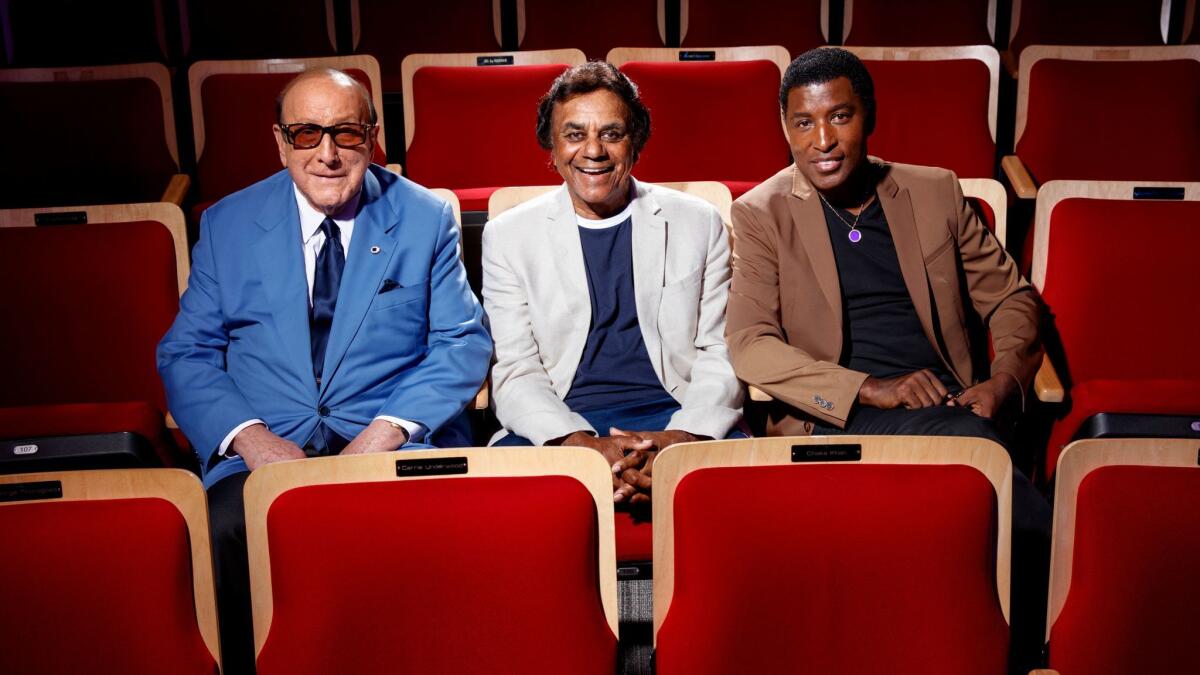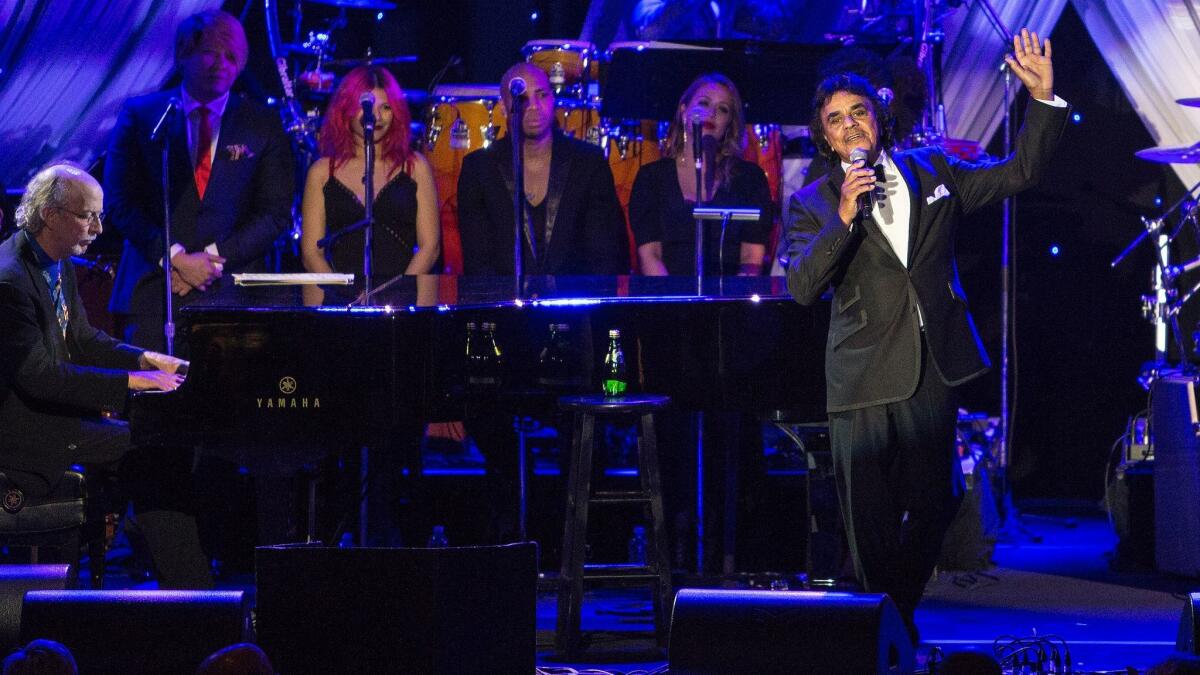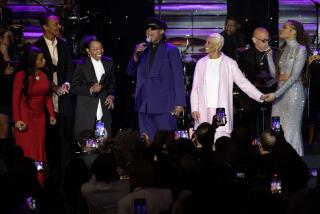How Taylor Swift gave Clive Davis the idea for Johnny Mathisâ âGreat New American Songbookâ

The first time Johnny Mathis and Clive Davis worked together closely, things didnât go quite as planned.
The year was 1973, and Davis â then the head of Mathisâ label, Columbia Records â had paired the old-fashioned romantic crooner with producer Thom Bell for âIâm Coming Home,â an album that set Mathisâ distinctive high-pitched voice against the lush R&B sound known as Philadelphia soul.
âI thought it was one of the best things Iâd done, and Tommy loved it,â Mathis said recently. âBut then Clive got fired before we could publicize the album, so it just kind of languished.â The singer laughed gently, recalling Davisâ untimely dismissal from Columbia after an expense-account scandal of which he was later cleared.
âNobody ever really heard it,â Mathis said of the album.
Forty-four years later, the two have reunited for a second collaboration they hope gets a more meaningful look. âJohnny Mathis Sings the Great New American Songbook,â which came out last month, follows a series of similarly titled efforts that Davis, now an executive with Sony Music, has overseen for Barry Manilow, Rod Stewart and Aretha Franklin.
But this time, Davis tweaked his established formula. Rather than summon the nostalgia of a graying audience â an approach that led to multiplatinum sales in the case of Stewartâs âGreat American Songbookâ discs â Mathisâ album presents the 82-year-old singer as a still-vital interpreter of modern pop, with clever renditions of recent radio staples in place of deeply familiar standards like âBeyond the Seaâ and âIt Had to Be You.â
âItâs the great new American songbook,â said Davis, 85, emphasizing the crucial word in his raspy New York accent.
Among the songs Mathis tackles: Adeleâs Grammy-winning âHello,â Bruno Marsâ chart-topping âJust the Way You Are,â Keith Urbanâs country hit âBlue Ainât Your Colorâ and, perhaps most surprisingly, âHappy,â the uptempo secular-gospel jam by Pharrell Williams.
What would Johnny do?
In their original incarnations, each tune is a big vocal record designed to attract attention. But Mathisâ album takes a different tack: Working in the studio with veteran R&B singer and producer Kenny Edmonds, known as âBabyface,â Mathis remade the songs to suit his delicate aesthetic â which, in an era of post-âAmerican Idolâ oversinging, means they actually stand out.
ââHow would Johnny do it?ââ Edmonds said he repeatedly asked himself while devising his airy arrangements. âEvery song came down to that.â
Mathisâ first studio album since a Christmas collection (one of his many) in 2013, âGreat New American Songbookâ came about as a result of the singerâs performance two years ago at Davisâ annual pre-Grammy gala at the Beverly Hilton.
The executive, who prides himself on a hot ticket of a show that routinely mixes young stars and respected legacy acts, remembered spotting Taylor Swift at a table near the front of the ballroom as he stood onstage to introduce Mathis.
âI told her, âTaylor, youâve had a great few years,ââ Davis said. ââBut this next artist, an album of his greatest hits was on the Billboard Top 200 for 10 consecutive years.ââ
As he recalled the episode, Davis was seated with Mathis and Edmonds in a green room at the Grammy Museum in downtown Los Angeles, where the three were scheduled to give a talk last week about the new album. (Its release on Sept. 29, one day before the end of this yearâs Grammy eligibility period, was certainly no coincidence.)
The space was filled with members of each manâs entourage, including Davisâ pal Nikki Haskell, a fixture of the New York social scene known for her long friendship with Donald Trump. Edmonds and Davis were nattily dressed â as they had been a couple of nights before at the premiere of a splashy new documentary about Davisâ long career â while Mathis wore the track pants and sneakers of a guy whoâd come straight from his morning workout.
âHey, partner!â the singer said when Davis arrived, to which the executive replied, âYouâre looking as fit as could be.â

Back at the 2015 party at the Beverly Hilton, Mathis lived up to Davisâ hype, bringing the audience of A-list guests to their feet with effortlessly assured renditions of âChances Areâ and âItâs Not for Me to Say.â
âIt was an amazing, amazing thing,â Haskell said. âThatâs a tough crowd, but the reaction was incredible.â
âIt was like a Beatles moment!â Davis added with typical extravagance, which seemed to make Mathis blush.
âI donât know, maybe I sang good,â he said.
According to Davis, the singerâs strong showing at the gala led his Sony bosses, Doug Morris and Rob Stringer, to demand that the executive come up with a concept for a Mathis album, and thus the ânew songbookâ idea was born.
Davis began compiling a list of tunes he thought Mathis could do well, but to help execute the vision he recruited Edmonds, not least because of the producerâs success on Barbra Streisandâs 2014 album âPartners,â which sold more than a million copies.
âHello,â Johnny
The call to join Mathis in the studio was a welcome one, Edmonds said.
âI grew up listening to Johnny â the Christmas records but also the records he did with Deniece Williams,â said the producer, referring to disco-era duets like âToo Much, Too Little, Too Lateâ and the duoâs take on Marvin Gaye and Tammi Terrellâs âYouâre All I Need to Get By.â
The two already knew each other socially; Edmonds remembered meeting Mathis at a Christmas party thrown by pop songwriter Carole Bayer Sager, while Mathis said he saw Edmonds perform recently at a private function at someoneâs home.
âReal rich man, in the hillsâŚ,â Mathis said, trailing off as he tried to place the name.
âHaim Saban,â Edmonds replied.
Yet the musicians had never collaborated until Davis brought them together.
âTo get to work with an icon â I was like, âYes, please,ââ the producer said.
Once they started recording, âthe important thing,â Edmonds said, âwas that we had to make sure this didnât become a karaoke albumâ â a charge that could be leveled at some of Stewartâs and Manilowâs records under Davisâ imprimatur.
âThis had to be an expression of Johnny.â
âGreat New American Songbookâ satisfies that ambition; it even brings Mathisâ signature ethereal quality to a pair of lung-busting pop-soul ballads from the 1990s: R. Kellyâs âI Believe I Can Flyâ and âRun to You,â first made famous by Davisâ highest-profile creative partner, the late Whitney Houston, in âThe Bodyguard.â
In his customary self-effacing manner, Mathis â whoâs scheduled to play the Agua Caliente casino in Rancho Mirage on Oct. 28 â said his vocal choices on the album reflect the only way heâs ever known how to sing.
âI have no control over it,â he said. âAll I do is open my mouth, and whatever comes out, thatâs the way it is.â
Still, he acknowledged that the âjuxtapositionâ of his delivery and our expectation of a more dramatic voice in a song like âHelloâ can provide an effective thrill.
âHow does my little thing work with this big thing?â he mused. âI still donât understand.â
One of Mathisâ favorite cuts on the album is âHappy,â which he said feels to him like a song for kids. Growing up in San Francisco in a family with seven children, the singer more or less raised his three younger siblings while his parents were away at work.
âAnd I had to sing songs like that for them,â he said. âItâs not contrived; itâs absolutely real. When I heard it, I said, âYeah!â
âI just hope Pharrell likes it,â he said of the multitasking artist whose oversize headgear made waves on social media after the 2014 Grammys. âI like him a lot. I donât know what he does, really.â
Edmonds and Davis chuckled in seeming recognition of Mathisâ unusual position: a pop star both in and out of time, someone interested in current music but not at all worried about fitting in.
âI mean, I know he does everything,â Mathis continued. âBut he confuses me with the hat.
âYou donât need the hat!â
Twitter: @mikaelwood
ALSO
Why losing Tom Petty feels like losing a piece of ourselves
Dave Grohl and Josh Homme on Cal Jam, rock ânâ roll and their decades-long bromance
More to Read
The biggest entertainment stories
Get our big stories about Hollywood, film, television, music, arts, culture and more right in your inbox as soon as they publish.
You may occasionally receive promotional content from the Los Angeles Times.











